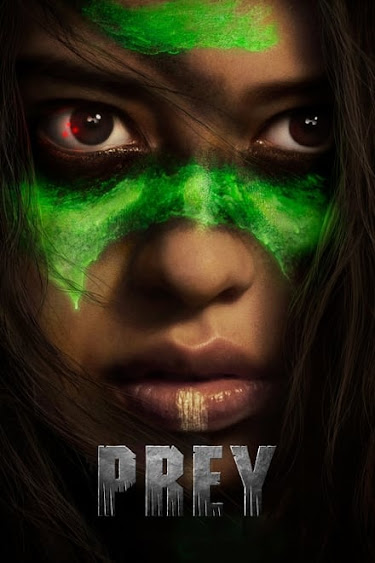PREY (2022) ★ ★ ★ ★
The last thing I expected from a "Predator" movie was a period piece, but with "Prey," that's exactly what I got. The story takes place in 1719, about three-hundred years before the events of the first film, and instead of muscled Vietnam veterans hoisting hand cannons in a tropical rainforest, our heroes are axe-wielding Native Americans of the Comanche Tribe in the region that became Nebraska or Wyoming. I don't think I've ever seen a more original backdrop for an entry in a schlocky sci-fi horror franchise, and director Dan Trachtenberg and writer Patrick Aison wisely made the time and place main characters in their film. But the true star is Naru, the young Comanche healer who dreams of being a hunter, played by 25 year-old Amber Midthunder in what ought to be her breakthrough role.
I've seen Midthunder in only one other film, 2021's "The Marksman," in which she has a tiny part as a clerk in a gas station. Her list of movie credits is impressive, stretching across twenty-three titles, all the way back to her 2001 debut in "The Homecoming of Jimmy Whitecloud." But "Prey" gave me a chance to see what she's capable of: she understands that the slightest shift of an eyebrow or twitch of the lips can convey a person's innermost self more effectively than hours of sequel-driven chest-thumping machismo ever could. Aison did a thorough job when he wrote the character for Naru, and he allows the audience to develop a feel for what she's capable of, what her weaknesses are, and what she desires most in life. He crafted a believable person, and the more realistic someone is on screen, the more we care about her. It's impossible to not care about Naru. Every element of her world is against her, yet nothing robs her of her desire to be seen as a hunter, which was traditionally a rite of passage for Comanche men.
We meet her as she's tracking a deer. She's alone, save for her dog, and her hunt is foiled by the sounds of a strange thunder overhead. This turns out to be a Predator spacecraft, and of course the audience knows this, but Naru interprets it as a visitation from the Thunderbird, which in Native American mythology is a supernatural entity that brings a warrior's strength to those who summon it. She seems to be the only member of her tribe who witnesses its arrival, and she considers it a sign that she must prove her hunting bona fides. She crashes her brother Taabe's hunting party when they set out to kill a lion, and comes face-to-face with the toothy feline. She wounds it and almost becomes its dinner, but not before she gets a glimpse of strange red lights out in the woods.
These events bring us to the realization that nobody believes Naru's observations because she's just a healer girl. What does she know? The screenplay conveys the gender roles in the tribe as being rigidly binary, and Naru's determination to break them is met with consternation from the boys and Taabe, who is played with what can only be seen as hereditary understatement by Dakota Beavers. But between their arguments are scenes of a frustrated warrior honing her skills. She improves the lethality of her throw-axe by tying it to a rope, which increases its directional control. (She later uses this invention to pull herself out of quicksand.) Spurred by scorn, she intensifies her observations of her environment, and notices a skinned snake carcass, which her facial expressions register as being unnatural. She stumbles across the work of French fur traders in a field littered with skinned bison. Naru explores and learns.
Trachtenberg develops her personality using location shots of overwhelming beauty, with artfully-framed takes of sprawling mountains, rolling fields, and babbling rivers. It wold be easy to dismiss her travails as modern political overcorrection if the film didn't do such a good job of contextualizing them in striking images of man against nature. She has no technology at her disposal, and any progress she makes is solely through survival. By the time the Predator shows up to engage with her, she's been humbled by several losses. She has tried and failed to prove herself, and hasn't even come close to winning the respect that she seeks. The alien meat-cleaver is her truest test, and if I hadn't seen how shrewd she was, I wouldn't have believed she could face-off with the same monster that sent Arnold Schwarzenegger running. The movie's greatest accomplishment is making this unlikely match plausible, and when Naru does square off with her homelier adversary, I'm primed to see her kick ass.
Spoiler alert: The only demerit I would pin to "Prey" is more of an abstraction of circumstances based on how the movie connects itself to "Predator 2." In Stephen Hopkins' film, a group of Predators give Danny Glover's character a flintlock pistol with the engraving "Raphael Adolini 1715," which is the exact same pistol Naru inherits from her interstellar pal, who had pinched it from one of the French. This suggests that despite claiming the gun as a trophy at the end of "Prey," Naru and her people are due for a second round with laser-face, and it doesn't go well for them. I don't know why Trachtenberg put the pistol in his final cut, or if he intended to impart this grim post-film outcome to fans, but I find myself wishing I hadn't learned about the pistol's provenance, at least not like this.
--- Bill Fontaine



